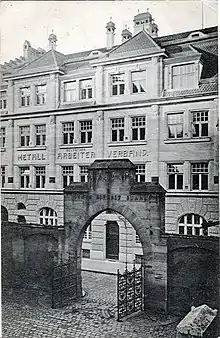German Metal Workers' Union
The German Metal Workers' Union (German: Deutscher Metallarbeiter-Verband, abbreviated DMV) was a German industrial union for metalworkers formed in 1891 and dissolved after the Nazis' accession to power in 1933.
Deutscher Metallarbeiter-Verband | |
 | |
| Successor | Industrial Union of Metal (E Germany), Industrial Union of Metal (W Germany) |
|---|---|
| Founded | 6 June 1891 |
| Dissolved | 2 May 1933 |
| Headquarters | Rötestraße 16, Stuttgart |
| Location |
|
Members | 1,632,670 (1920) |
| Publication | Deutsche Metall-Arbeiter-Zeitung |
| Affiliations | ADGB, IMF |
History

German metalworkers started to organize in labor unions in 1868. In 1891, at a congress in Frankfurt from June 1 to June 6,[1] a number of separate unions joined forces to form a single federation with 23,200 members. The DMV was the first industrial union in the country.[2] It was headquartered in Stuttgart. It took over publication of the already extant newspaper Deutsche Metall-Arbeiter-Zeitung. At first, it faced opposition from the established craft unions. Its membership reached 50,000 by 1896, 100,000 in 1901, and over 500,000 by 1913. Its growth was slowed by its failure to gain recognition by employers in large plants in heavy industry until World War I.[3]
During World War I, the DMV, like the rest of the socialist labor movement, did not oppose the country's war efforts and maintained labor peace, a policy known as the Burgfrieden. As the war effort unraveled and revolutionary struggles broke out, metalworkers rebelled as well. They were a major part of the January Strikes, though the union itself helped re-establish order. After government control collapsed in November 1918, most leaders had to leave their posts as a result of having supported the war.[4] Once order was restored, the DMV, which was part of the Allgemeiner Deutscher Gewerkschaftsbund (ADGB), a confederation of socialist unions,[5] attained recognition from employers and its membership spiked to 1.6 million in 1919, briefly making it the single largest union in the world.[6] It was, however, unable to attract younger workers throughout the Weimar years and its membership sank to under a million by 1928.[7] During the 1920s, communists from the Communist Party of Germany (KPD) had considerable influence in the DMV.[8]
After the Nazis gained power in 1933, the DMV was banned on May 2. Many of its leaders were imprisoned and taken to concentration camps and the union's assets and property were seized. Some of its organizational structures were integrated into the German Labor Front (DAF), the Nazi Party's labor organization.[9] Although the DMV opposed the Nazis, it was unable to put up meaningful resistance against their rule.[10]
After World War II, in 1949, IG Metall was established as the new German federation for metalworkers. It continued the DMV's tradition, but strove to maintain political neutrality, feeling that political discord in the German labor movement had contributed to the Nazis' victory in 1933.[11]
Mergers
The union absorbed several smaller unions:[12]
- 1892: Union of Locksmiths and Mechanical Engineers
- 1897: Berlin Metalworkers' Union
- 1900: Union of Gold and Silver Workers
- 1901: Central Union of German Formers
- 1905: German Shipyard Workers' Union (part)
- 1905: Union of Hanau Gold and Silver Workers
- 1907: Union of Engravers and Chasers
- 1912: Central Union of Smiths
- 1921: Association of Railway Craftsmen
- 1924: Central Association of Ship Builders of Germany
Presidents
- 1891: August Junge
- 1895: Alexander Schlicke
- 1919: Alwin Brandes, Robert Dißmann and Georg Reichel
- 1921: Alwin Brandes, Willy Eggert and Georg Reichel
- 1926: Alwin Brandes and Georg Reichel
Footnotes
- Scherm 1932, pg. 376
- Doherty/van der Velden 2012, pg. 86.
- Doherty/van der Velden 2012, pg. 86; Gerstenberg 2013.
- Gerstenberg 2013.
- Klosek 2013, pg 10.
- Doherty/van der Velden 2012, pg. 86.
- Doherty/van der Velden 2012, pg. 86.
- Weitz 1997, pg. 141.
- Gerstenberg 2013.
- Klosek 2013, pg. 10
- Gerstenberg 2013.
- "Deutscher Metallarbeiter-Verband" (PDF). Friedrich Ebert Stiftung. Retrieved 24 June 2020.
References
- Doherty, James C.; van der Velden, Sjaak (2012). Historical Dictionary of Organized Labor.
- Gerstenberg, Günther (25 November 2013). "Deutscher Metallarbeiter-Verband (DMV), 1891-1933". Historisches Lexikon Bayerns. Bayerischen Staatsministerium für Bildung und Kultus, Wissenschaft und Kunst. Retrieved 29 September 2014.
- Klosek, Artur (2013). Quo vadis, deutsche Gewerkschaften? Herausforderungen im globalisierten 21. Jahrhundert am Beispiel der IG Metall: Aktuelle Entwicklungen und Perspektiven.
- Scherm, Johann (1932). "Deutscher Metallarbeiterverband (DMV)". In Heyde, Ludwig (ed.). Internationales Handwörterbuch des Gewerkschaftslebens. pp. 375–380.
- Weitz, Eric D. (1997). Creating German Communism, 1890-1990: From Popular Protests to Socialist State.
External links
 Media related to Deutscher Metallarbeiter-Verband at Wikimedia Commons
Media related to Deutscher Metallarbeiter-Verband at Wikimedia Commons- Clippings about German Metal Workers' Union in the 20th Century Press Archives of the ZBW